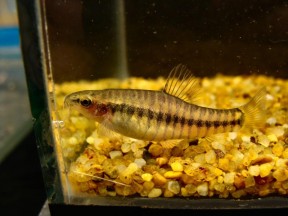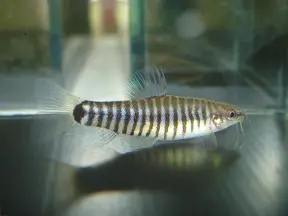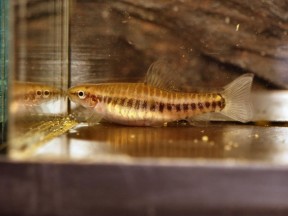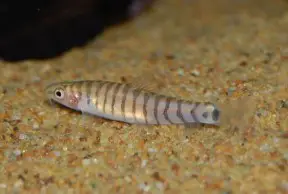Micronemacheilus cruciatus
SynonymsTop ↑
Yunnanilus cruciatus (Rendahl, 1944); Nemacheilus cruciatus Rendahl, 1944; Micronemacheilus curciatus (Rendahl, 1944)
Etymology
Micronemacheilus: from the Greek μικρός (mikrós), meaning small, νήμα (nēma), meaning ‘thread, filament’ and χείλος (cheilos), meaning ‘lip’ in reference to the fact that this genus possesses a furrowed lip as in Nemacheilus spp. but has a smaller adult size.
cruciatus: from the Latin crux, meaning ‘cross’, in reference to this species’ colour pattern which comprises a dark lateral stripe with numerous vertical cross-bars.
Classification
Order: Cypriniformes Family: Nemacheilidae
Distribution
This species was described from ‘Thua Luu, 50 kilometers south of Hué, Vietnam’ but subsequently recorded from all rivers draining the Vietnamese coast between 14°30′ and 18°00’N. It appears to be endemic to Vietnam.
Habitat
We’ve been unable to obtain any precise information, but related species inhabit slow-moving sections or backwaters of minor rivers and streams, or permanent water-bodies such as lakes, ponds, and swamps where they tend to be associated with patches of aquatic vegetation.
Maximum Standard Length
35 – 40 mm.
Aquarium SizeTop ↑
Base dimensions of 60 ∗ 30 cm or equivalent are required given that it’s best-maintained in numbers.
Maintenance
Best kept in a densely-planted tank and an excellent choice for the carefully-aquascaped set-up. The addition of some floating plants and driftwood roots or branches, and leaf litter also seems to be appreciated and adds a more natural feel.
If you wish to raise fry alongside the adults the addition of fine-leaved aquatic moss such as a Taxiphylum sp. is advisable (see ‘Reproduction’).
The water should be well-oxygenated but not turbulent though a degree of flow is acceptable. Do not add this fish to a biologically immature aquarium as it can be susceptible to swings in water chemistry, and be sure to perform regular partial water changes to maintain quality.
Water Conditions
Temperature: 22 – 27 °C
pH: 6.0 – 7.5
Hardness: 36 – 215 ppm
Diet
Probably a micropredator feeding chiefly on small insects, worms, crustaceans, and other zooplankton in nature.
In the aquarium it must be offered items of a suitable size and quality, particularly live Daphnia, Moina, Artemia nauplii, micro worm, etc. Small or crushed floating dried foods are also accepted and should ideally contain some plant or algal material.
Behaviour and CompatibilityTop ↑
Peaceful and likely to be intimidated or outcompeted for food by larger or more boisterous tankmates, although the presence of similarly-sized schooling fishes seems to help reduce shyness.
Small cyprinids from genera such as Boraras, Microdevario, Trigonostigma, Tanichthys, and Microrasbora plus smaller danios such as D. erythromicron or D. margaritatus are perhaps the best options, and we suspect many small characids would also be fine. Many peaceful loaches and catfishes should also prove suitable but as always research your choices thoroughly in order to avoid problems.
M. cruciatus is highly gregarious and should be kept in a group of at least 8-10 specimens, ideally more. Maintaining it in such numbers will not only make the fish less nervous but result in a more effective, natural-looking display.
Unlike most loaches they also spend a lot of time in the open, often hovering in midwater and exploring all levels of the aquarium. Reports suggest that individuals naturally becomes more reclusive as they age, however, with older fish tending to conceal themselves more routinely.
Sexual Dimorphism
Sexually mature females are usually rounder-bellied and a little larger than males.
Reproduction
This species is an egg-scattering spawner that displays no parental care. If the fish are in good condition they will spawn often and in a densely-planted, mature aquarium it’s possible that small numbers of fry may start to appear without intervention.
However if you want to increase the yield of fry a slightly more controlled approach is required. The adult group can still be conditioned together but one or more smaller, perhaps 10-15 litre, containers should also be set up and filled with aged water.
Fill much of the available space with fine wool mops, Taxiphyllum or other fine-leaved plant. Neither lighting nor filtration is necessary although you can install a small air-powered sponge filter if you prefer.
When the adult fish are well-conditioned a single pair or group comprising several of each gender can then be introduced to each container, though it’s worth noting that the more individuals involved the greater the risk of egg predation.
Spawning is initiated by the male(s) with the female being driven into the mops or plants where eggs are released singly, often on a solid surface such as a plant leaf or directly on the aquarium glass.
If numbers are limited two or more males may attempt to spawn with a single female simultaneously, and once eggs are spotted the adults are best removed as they will eat any they find.
Incubation is temperature-dependant to an extent but once the fry are free-swimming initial food should be Paramecium or a proprietary dry food of sufficiently small (5-50 micron) grade, introducing Artemia nauplii and/or microworm once they are large enough to accept them.
NotesTop ↑
This species is traded under various names including ‘Vietnamese multi-banded zebra loach’, ‘hovering zebra loach’, ‘Laos pygmy multi-stripe loach’, and ‘banded dwarf loach’.
It can be distinguished from related species by the following combination of characters: body relatively deep and with distinct vertical bars; 8½ branched dorsal-fin rays; 3-10 pored lateral line scales; one pair of large papillae in median portion of upper lip; two pairs of large papillae in median portion of lower lip; lower posterior edge of opercle with 3-4 prominent indentations.
Rendahl (1944) described Nemacheilus cruciatus and established the genus Micronemacheilus for it. There it remained until 2001 when Frehyof and Serov moved it into Yunnanilus based on the fact it shares most of the diagnostic characters for the genus given by Kottelat (1988).
The large papillae in the median portion of both lips and indentations along the posterior of the opercle are not characters associated with other Yunnanilus spp. but neither were they considered sufficient to justify retention of Micronemacheilus.
Kottelat (2012) considers Micronemacheilus to be valid, however, with M. cruciatus the sole representative. No additional information is provided.
The family Nemacheilidae is widely-distributed across most of Eurasia with the Indian subcontinent, Southeast Asia and China representing particular centres of species diversity.
It was first proposed as a genetically-distinct grouping in the 1980s but did not become widely-accepted until 2006. According to current knowledge it contains over 30 genera of which the most well-known in the aquarium hobby include Aborichthys, Acanthocobitis, Barbatula, Mesonoemacheilus, Nemacheilus, Physoschistura, Schistura, and Petruichthys.
References
- Rendahl, H., 1944 - Göteborgs Kungliga Vetenskaps-och Vitterhets-Samhälles Handlingar (Ser. 6 B) v. 3 (no. 3): 1-54
Einige Cobitiden von Annam und Tonkin. - Bănărescu, P. M. and T. T. Nalbant, 1995 - Travaux du Muséum d'Histoire Naturelle : 429-495
A generical classification of Nemacheilinae with description of two new genera (Teleostei: Cypriniformes: Cobitidae). - Freyhof, J. and D. V. Serov, 2001 - Ichthyological Exploration of Freshwaters 12(2): 133-191
Nemacheiline loaches from Central Vietnam with descriptions of a new genus and 14 new species (Cypriniformes: Balitoridae). - Kottelat, M., 2012 - Raffles Bulletin of Zoology Supplement 26: 1-199
Conspectus cobitidum: an inventory of the loaches of the world (Teleostei: Cypriniformes: Cobitoidei). - Kottelat, M., 2013 - Raffles Bulletin of Zoology Supplement No. 27: 1-663
The fishes of the inland waters of southeast Asia: a catalogue and core bibiography of the fishes known to occur in freshwaters, mangroves and estuaries. - Kottelat, M. and X.-L. Chu, 1988 - Environmental Biology of Fishes 23(1-2): 65-93
Revision of Yunnanilus with descriptions of a miniature species flock and six new species from China (Cypriniformes: Homalopteridae).






October 13th, 2012 at 1:45 am
Does this species eat snails?
January 7th, 2013 at 5:46 pm
No. Mine never did.
September 9th, 2014 at 4:42 pm
Not shy at all! From day one, they eat anything and aren’t affraid to swim through a school of Tanichthys micagemmae to get some flakes. Lovely active fish!
About the snails, maybe the smallest, but certainly no adult snails!
May 19th, 2017 at 3:18 am
Keeping Micronemacheilus cruciatus with Physella acuta and in my experience they dont bother the snails. They seem to have small mouths and in my experience they prefere small live, frozen or flake food that has been grinded to smaller pieces. When it comes to live worms and insects they seem to be able to handle a bit larger snacks than when it comes to frozen or flake. I dont think they eat planaria worms. This species is not suitable for “pest control” IME. They work nice with Amano Shrimp.
April 6th, 2019 at 4:45 pm
I love these loaches!! Great for a 10 gallon nano tank planted tank. Mine are not shy. They prefer meatier food like bloodworms but will eat flakes too. I have noticed some vary small snail shells, perhaps they ate them. They constantly forage the substrate but have not uprooted any plants.
I have them with Ember Tetras (Hyphessobrycon amandae) and blue Neocaridina shrimp. Six is a nice group. Them will escape, I have lost two this way. They like to swim into current. I noticed this when filling the tank with a pump. All of them school into the flow from the pump. Fish that like to swim into current seem to tend to be escape artists also….:)